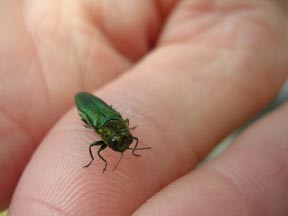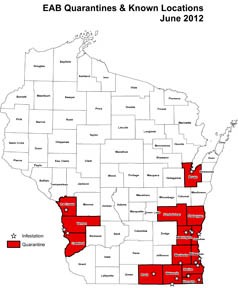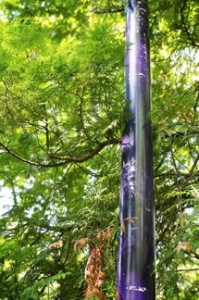Stopping Invasive Hitchhikers
- Share
- Tweet
- Pin
- Share
Emerald ash borer, an invasive insect that has devastated areas of the Midwest, has been found in Green Bay.

The emerald ash borer is responsible for killing over 50 million ash trees in the Midwest. Photo by Bill McNee, DNR entomologist.
Although nobody has seen the shiny green bugs in Door County, they may already be here and creeping inside the county’s 14.4 million ash trees.
“My gut feeling, my professional opinion, is that it’s probably in Door County somewhere, but we have not found it,” said Bill McNee, entomologist for the Department of Natural Resources.
Emerald ash borers came over from Asia on shipping crates, McNee said. They were first seen in Michigan about 20 years ago, and have since spread as far as Tennessee, New York and Minnesota.
And Green Bay.

Emerald ash borers, an invasive pest, have been located as close to Door County as Green Bay. On their own, the insects spread about a half mile each year.
A dead emerald ash borer was found in Green Bay in 2009, but for the next two years there had been no signs of an infestation by the insect. This year, when Mark Freberg of the Green Bay forestry department showed up on the scene, it was a different story. The bugs had taken over, and trees were dying.
“You could really see it, where in the last few years you couldn’t see anything,” Freberg said. “It was almost like popcorn under the bark. They just came popping out.”
That’s how emerald ash borers work. Their larvae can live in a tree for years before the tree shows any signs of damage, so it’s hard to know where the bugs live until an area is crawling with them.
Adult beetles lay eggs in the tops of ash trees, and when they hatch, larvae eat away at the layer under the bark that transports water and nutrients. Eventually, the trees can’t get nutrients from roots to branches, and they die.

This purple tube coated with fly paper is used within Peninsula State Park to study if the emerald ash borer is present. At this point, no emerald ash borers have been found. Photo by Len Villano.
When the bugs grow up, they bore their way out of the tree bark and leave d-shaped holes.
American ash trees don’t have any defenses built up to survive an infestation of the invasive bug, which is responsible for killing over 50 million ash trees in the Midwest. Infested trees usually last about five years.
“The trees are basically doomed regardless of how healthy they are,” McNee said.
The insects spread pretty slowly on their own, only about a half mile each year. At that rate, they would reach Door County in about 30 years. But the bugs are known hitchhikers and often catch rides on firewood to get to new places.
“In the back of an RV or a truck, they can go hundreds of miles a day,” McNee said.
To keep emerald ash borers from spreading, experts have been trying to educate people who may move infested logs or firewood to a new place and expand the bug’s range.
Campers are well informed this summer about the risks of moving firewood, said Don McKinnon, superintendent at Potawatomi State Park. Park officials have only had to confiscate 20 or 25 bundles of firewood, which is much less than in past years.

State parks are educating people about the implications of the emerald ash borer, urging people not to transport firewood. This sign is found at Peninsula State Park next to an informational kiosk. Photo by Len Villano.
“People are aware of emerald ash borer,” McKinnon said. “We’ve known about it and had restrictions for the past four years now.”
It’s a state park rule that campers can’t bring firewood from over 25 miles away, so most end up buying it from the park concessions. Counties that have known infestations, like Brown County, are quarantined, meaning wood can’t be transported out of the infested counties to a non-quarantined area.
It is possible to save an ash tree – but it comes at a price. An insecticide has to be given to the tree every year or two, which may be practical for a few ornamental trees but not for all 700 million of Wisconsin’s ash trees, McNee said.
He doesn’t recommend treating ash trees until emerald ash borers have been found in the county.
There are 7,000 ash trees on public property in the city of Green Bay, and Freberg estimates there are 70,000 in the whole city. That’s about 17 percent of the city’s trees that most likely won’t last for long.
“It’s going to be this generation’s Dutch elm disease,” Freberg said.
